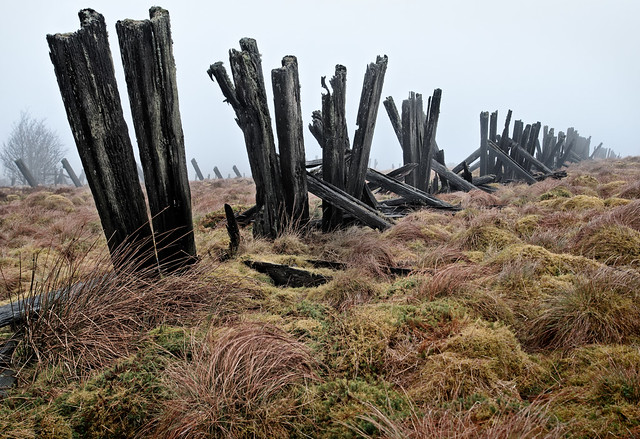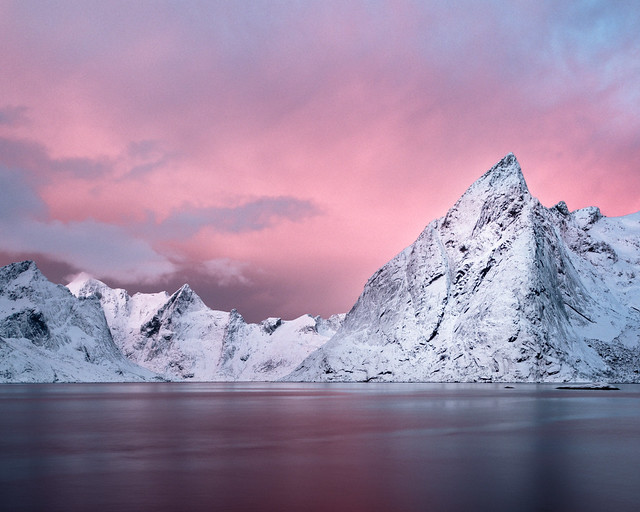Musings on: are desaturated images more expressive than mono or ‘full colour’?
I was thinking of entitling this article:
“is the preference some people have for muted, desaturated or ‘dull’ colours a deliberate overlay of what we consider to be ‘refined taste’ on our natural liking for exuberant, saturated, vibrant colour?”
That seemed a little long for a title, but it’s essentially what this posting is about. Put another way: do we – some of us – find less saturated colour more appealing because it’s ‘more artistic’ than vivid colours? If so, then is this preference, to put it slightly pejoratively, an attempt to be terribly clever, civilised and sophisticated by suppressing our instinctual attraction to the more lurid end of the saturation scale?
To start with, I probably ought to declare which side of the fence I’m on here. I like desaturated colour. In fact, I like black and white images, I just haven’t managed to get the hang of creating them as yet; and I don’t prefer them over colour. Having said that, I also like some images which have plenty of colour, though those tend to be abstracts rather than representative landscapes. Certainly, what I like to make is on the more muted end of the scale. So this is in part a musing on whether I’m being pretentious in that … I think not, and I’ll explain why, but I’m clearly biased ;-)
I should also mention that this is effectively part two of my previous article on whether there is such a thing as ‘over-saturation’. I concluded in that piece that, provided the photographer isn’t misrepresenting what they’ve made – claiming that their images faithfully reproduce reality when they don’t – the degree of saturation is purely a matter of taste and artistic intent. That, then, is the starting premise for this musing. (Incidentally, the idea that two-dimensional images can ever ‘faithfully represent’ reality is decidedly suspect, but that’s probably a subject for another musing!)
We are instinctively attracted by saturated colour
Perhaps a worthwhile perspective is to explore just why it is that people are drawn to bright colours. Yes, there is always the argument that photo-processing software allows us to intensify colours, so we do, and such manipulation undeniably produces arresting images when seen in thumbnail galleries; but why do people notice bright colours in the first place? Maybe it’s just how we are? And if it is, then perhaps the fashion for admiring muted colouration really is a subconscious, or even deliberate, statement that we have overcome our natural state of gasping and saying “wow” when we see something bright and shiny?
I think it’s undeniable that we are naturally attracted to the bright and saturated in our world. That could be down to any number of things, so here are a few ideas, extensively backed up by no scientific knowledge whatsoever on my part. I’m merely speculating on how pre-civilisation humans might have benefited by having their attention drawn to objects or phenomena exhibiting saturated colours.
- Orange and red tend to indicate heat, which in turn implies danger. It’s in our interests to notice and examine the source of such colours. Conversely, heat is remarkably useful to survival so, either way, spotting things with ‘hot’ colours would be a helpful trait. The more saturated they are, the more heat: again, potentially a very good thing to notice.
- Fruit and berries are often brightly coloured and they generally constitute food. Without a convenient shop to go foraging in, I’m sure it would be beneficial to be visually drawn to pick out such things.
- Similarly, bright, verdant green – the brighter the better – also tends to indicate food nearby, as well as that vital resource, water. With water being so fundamental to survival, finding bright greens with splashes of other colours would generally indicate access to food, warmth, water, continued health and all those things which make us comfortable.
- In contrast to all of the above, grey, desaturated and drab colours suggest cold. Humans aren’t really fond of the cold in general, so we’re inclined to disfavour anything which looks uncomfortable.
If any or all of the above are true, then we in the 21st century have developed from people who were quite rightly inclined to seek out colour, either to enjoy what it promised or to recognise it as danger. Either way, it would be both eye-catching and attractive, in the literal sense of making us want to go and look more closely. If so, it’s perfectly understandable that we should continue to behave in the same way when presented with images of the World around us.
I’ll make the rash assumption that the above is true …
Given that saturated colour is instinctively attractive to us, it follows that, as we strive (or profess?!) to become more sophisticated, perhaps actively rejecting these historical preferences really is an attempt to overcome instinctual behaviour and to demonstrate our high level of education by preferring things which we would not naturally like over those which we should be drawn to? I’m not necessarily saying that it’s a conscious effort; it could easily be unconscious, a rebellion against succumbing to instinct.
If that’s the case then I’m certainly guilty! As my work reflects, I very much like desaturated images, though not to the exclusion of colour when it’s appropriate. I don’t think rejection of instinct is entirely ‘it’ though; for me there’s more to it than that: I have a vision of what I’m drawn to most, and hence what I like to create, and it simply isn’t primarily about colour. Indeed, colour can detract often from that vision, so my inclination is to remove it rather than add more.
But then, what about black and white, or mono?
Monochrome images abstract wildly from reality, whether they’re of landscapes or anything else. We don’t see in mono, so any image consisting solely of tonality is categorically unnatural and simplified. To me, these features mean that the compositional aspects of the image are both more apparent and more important when mono is employed. Without colour, we’re left with tonality used to express patterns, textures and shapes. That, in my opinion, is a good thing – it’s less ‘obvious’.
A recent, non-photography experience of the near-removal of colour convinced me of this even more. I was watching Danza Contemporanea de Cuba in Newcastle a couple of weeks ago. As with most contemporary dance, there were colours involved in the clothing for two of the three pieces, but the last, accompanied by Steve Reich’s repetitive, purely percussion piece ‘Drumming’, was in near black and white. I was very aware of how the lack of colour and the simplicity of the instrumentation, gave added prominence to the patterns of movement and shapes formed by the choreography. The other two pieces that evening benefited from the colours used; this one benefited from the lack of colour. I think this has a direct parallel in desaturated photographs.
Even that isn’t entirely ‘it’ though; if it was, I’m sure I’d have taught myself how to pre-visualise and post-process in black and white by now!
Desaturated colour offers the best of both worlds
I have concluded that I actually prefer to use the slightly desaturated look over either mono or colour: it can be more expressive since it retains the ability to use the colour dimension of the capture, yet also makes shapes, tonality and composition relatively more important than they would be in a ‘full colour’ image. I don’t want colour to be the dominant feature of images, but nor do I want to use purely tonality. For me, desaturating colours slightly, but not to the point of monochrome, offers the best of both worlds: it avoids an image shouting “look at me, I’m colourful” and allows the otherwise more subtle compositional aspects to feature more strongly in the viewer’s emotional reaction to the photograph. I’ll summarise this as:
over-saturation tends to dominate an image, whilst removing colour completely loses a major dimension of many images; desaturating colour can balance all the dimensions better and give a greater emotional impact, or at least more freedom of expression in attempting to create that impact.
This has been an interesting subject to think about and I’ve definitely clarified and changed my views somewhat. I conclude that what matters to me in choosing how to manipulate saturation in my images is achieving some kind of balance which conveys to the viewer the emotional response I had to the scene I captured. Generally, removing some of the colour gives prominence to the things which matter more to me, without abstracting too far from reality by going all the way to mono.
Of course, any given image may ‘balance’ better with either lots of colour or no colour; it just seems to me that slightly reduced colour most frequently provides the best balance in the images I want to create. Ultimately, for any photographer, any manipulation of saturation is purely personal, artistic vision. What matters is why it’s done, what the final effect is, and whether what has been done adds to the artistic statement the photographer was trying to make.
I’d be very interested to hear your views on the above, so please comment if you have anything to add or want to agree or disagree!



